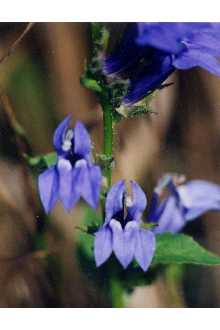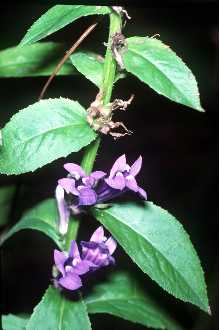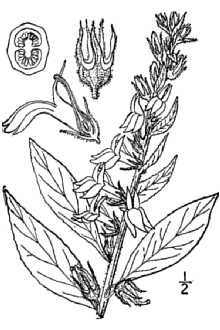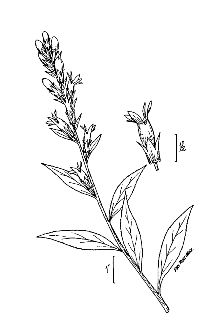Great Blue Lobelia
Scientific Name: Lobelia siphilitica L.
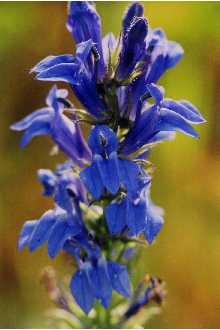
| General Information | |
|---|---|
| Usda Symbol | LOSI |
| Group | Dicot |
| Life Cycle | Perennial |
| Growth Habits | Forb/herb |
| Native Locations | LOSI |
Plant Guide
Uses
Ethnobotanic: The Iroquois used the plant as a cough medicine. The Meskwaki ground up the roots of this plant and used it as an anti-divorce remedy. The mashed roots were secretly put into some common dish, which was eaten by both husband and wife. The Cherokee used a cold infusion of the roots of great blue lobelia and cardinal flower to treat nosebleed. A poultice of the crushed leaves of the plant was used for headache and a warm leaf infusion was good for colds. Wildlife: Hummingbirds are attracted to the nectar.
Status
Please consult the PLANTS Web site and your State Department of Natural Resources for this plant’s current status, such as, state noxious status and wetland indicator values.
Description
General: Bellflower Family (Campanulaceae). This herbaceous perennial is 5 to 15 dm high with frequently branched, erect stems. The alternate leaves are toothed and narrowly oblong to elliptic to lanceolate or oblanceolate. The leaves are 8-12 cm and narrow to a sessile base. The irregular, two-lipped flowers are blue. They appear in long terminal racemes and are from 15-33 mm long. The corolla has a slit on each side near the base. The seeds come in a two-celled, many-seeded capsules opening at the top. The capsules have an ear-lobed or auriculate base. © Hugh Wilson Vascular Plant Image Gallery @ Texas A & M University
Distribution
This plant is found in swamps and wet ground from Maine to Manitoba and Colorado, south to North Carolina and Texas, For current distribution, please consult the Plant Profile page for this species on the PLANTS Web site, , Use soil moisture sensors to measure the soil moisture of Great Blue Lobelia.
Establishment
General: Great blue lobelia is comparatively easy to grow. The capsules can be collected in autumn, usually October. The stalks are cut below the capsules, and placed upside down in a per sack. Once, home, the bag is opened so that the capsules are exposed to the air for a few days. Shake the bag to release the seeds. The capsules that have remaining seeds can be retrieved and crushed with a rolling pin and seeds picked from the litter. The seeds can then be planted right away. Propagation by seeds: The seeds will germinate without cold stratification, but they need light, so sow the seeds in a flat with a damp fine grade peat lite mix. Keep the flats moist and under lights or in a greenhouse. They should green up in a few weeks. Transplant them in 4-6 weeks into individual pots such as 70 cell plug trays, use the same potting mix and keep fertilizing. The seedlings are tiny at first, so fertilize them every other week with a liquid fertilizer. After another 4 weeks they can be put out in the garden or transplanted into larger pots of 4 to 6 inch diameter. Plant the plants in an outdoor spot that is in full sun or very light shade and never dries completely. Space the plants 8 to 12 inches apart. Add plenty of peat moss when planting and mulch well to keep the soil cool and moist. Protect the plants from deer. Great blue lobelia will usually bloom in the first year. Allow the plants to self-sow. They are heavy feeders, so compost or apply granular fertilizer when they begin growth. Propagation by cuttings: Take two node stem cuttings (4-6 inches) before the flowers open and remove the lower leaf and half the upper leaf. Treat the cutting with hormodin 2 or root-tone and place the cuttings in a sand and perlite medium, cover lightly, water, and keeping the medium moist. Roots will form in 2-3 weeks, but the cuttings need to force a good new crown from the lower node to successfully over-winter.
Management
When well established, clumps of this plant can be divided in the fall or spring by separating the basal offshoots from the mother plant and replanting these divisions and watering them immediately. Cultivars, Improved and Selected Materials (and area of origin) Seeds and plants of selected Lobelia siphilitica are available from many nurseries. It is best to plant species from your local area, adapted to the specific site conditions where the plants are to be grown. Contact your local Natural Resources
Conservation
Service (formerly Soil Conservation Service) office for more information. Look in the phone book under ”United States Government.” The Natural Resources Conservation Service will be listed under the subheading “Department of Agriculture.”

